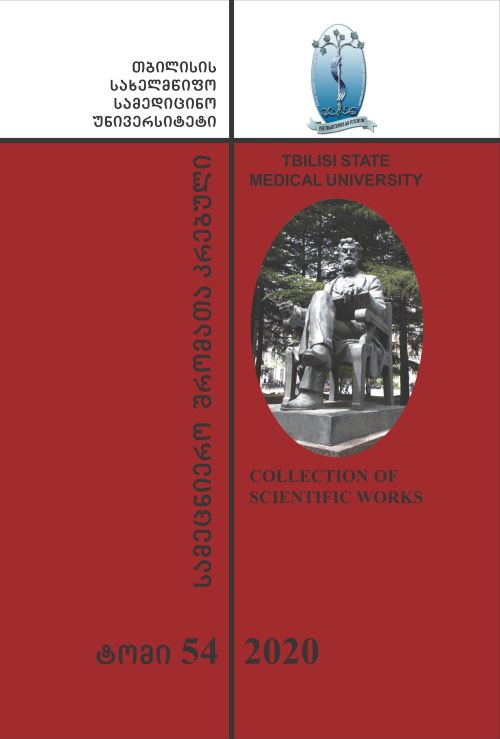Abstract
In the period from September 2019 to December 2020, a prospective observational study was conducted on 25 consecutive patients (2 female, 23 male) with pilonidal sinus at Academician Fridon Todua Medical Center. They were operated on an outpatient basis with the method of laser obliteration using a diode laser device (BioLitec, Germany). The evaluation criteria were the duration of complete obliteration of the sinus tracts, the frequency of complications, recurrence rate, the intensity of intra- and postoperative pain, cosmetic results, as well as duration of surgical intervention, length of hospital stay, the period of incapacity for work. The average follow-up period amounted to 9,7 months (2-15 month).
References
Dawson P. (2017) PilonidalDisease. In: Herold A., Lehur PA., Matzel K., O'Connell P. (eds) Coloproctology. European Manual of Medicine. Springer, Berlin, Heidelberg. https://doi.org/10.1007/978-3-662-53210-2_8
გელა მუხაშავრია,მაია ქარაბაკი(1998წ) - პროქტოლოგია
Дульцев Ю.В., РивкинВ.Л. Эпителиальный копчиковый ход -М: Медицина, 1988.- 129
G. E. Karydakis, "Easy and successful treatment of pilonidal sinus after explanation of its causative process," Australian and New Zealand Journal of Surgery, vol. 62, no. 5, pp. 385389, 1992
Iesalnieks I, Ommer A, Petersen S, Doll D, Herold A. German national guideline on the management of pilonidal disease. Langenbecks Arch Surg. 2016 Aug;401(5):599-609. doi: 10.1007/s00423-016-1463-7. Epub 2016 Jun 16. PMID: 27311698
Johnson EK, Vogel JD, Cowan ML, Feingold DL, Steele SR;The American Society of Colon and Rectal Surgeons' Clinical Practice Guidelines for the Management of Pilonidal Disease. Dis Colon Rectum. 2019 Feb;62(2):146-157. doi: 10.1097/DCR.0000000000001237. PMID: 30640830.
Dessily M et al (2017) Pilonidal sinus destruction with a radial laser probe: technique and first Belgian experience. ActaChirBelg 117(3):164168
Pappas A, Christodoulou D. A new minimally invasive treatmentof pilonidal sinus disease with the use of a diode laser: a prospectivelarge series of patients. Colorectal Dise-ase. 2018; 20(8):O207-O214.http://doi: 10.1111/codi.14285.
Kober MM, Alapati U, Khachemoune A. Treatment options for pilonidal sinus. Cutis. 2018 Oct;102(4):E23-E29. PMID: 30489572.
Calikoglu, Ismail M.D. Gulpinar, Kamil M.D. Oztuna, Derya Ph.D.Elhan,Atilla Halil Ph. Phenol Injection Versus Excision With Open Healing Pilonidal Disease: A Prospective Randomized TrialDiseases of the Colon & Rectum: February 2017 - Volume 60 - Issue 2 - p 161-169.
M Emiroglu; C Karaali; SSalimoglu; ISert; LUgurlu; CAydýnThe Effect of Phenol Concentration on the Treatment of Pilonidal Sinus Disease: Early Results of a Prospective Randomized Study IntSurg (2016) 101 (3-4): 127132. https://doi.org/10.9738/INTSURG-D-15-00120.1
Marco Milone, Loredana Maria Sosa Fernan-dez , Mario Musella , Francesco MiloneSafety and Efficacy of Minimally Invasive Video-AssistedAblation of Pilonidal Sinus: A Randomized Clinical Trial. JAMA Surg. 2016 Jun 1;151(6):547-53.
